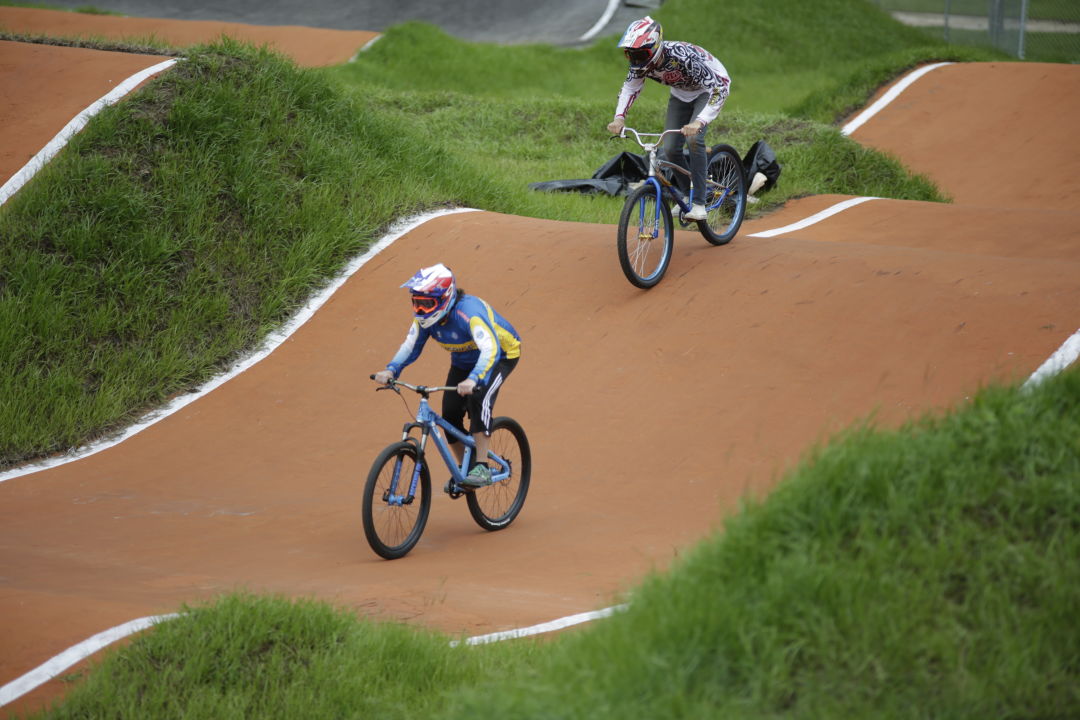We Tried It: BMX

Hannah Wallace, front, and Cooper Levey-Baker at the Sarasota BMX track.
Image: Salvatore Brancifort
On Aug. 8, 2016, the morning of my 37th birthday, I stood astride a BMX bicycle, flanked by a few dozen Olympians, atop a three-story starting ramp at the Sarasota BMX track, saying to myself, “I might be too old for this.” Then the starting light ticked its countdown: red…yellow…go.
This was my introduction to Sarasota BMX, a 40-year-old facility at Tuttle Avenue and 17th Street that recently underwent a multimillion-dollar overhaul. The company responsible for the renovations, Ohio-based Elite Trax, also built the Olympic BMX track in Rio—hence the world-class athletes, men and women, there that day to witness my first-ever BMX ride. They were all in the final stages of training, just days away from competing in the Brazil games. (Among them: Colombia’s Mariana Pajón, who would go on to win gold.) Not only is Sarasota’s now-state-of-the-art course ideal for Olympic training, but BMX teams from countries like Norway and the Netherlands were using our balmy Florida summer to help acclimate for South American competition.
And then there was me, propped up on a borrowed bike, wearing helmet and goggles that blinded my periphery and turned all sound into distant echoes—save for the thud of my own heartbeat.
My first-ever BMX lesson had started just 20 minutes earlier, alongside fellow associate editor Cooper Levey-Baker. Elite Trax’s Johan Lindstrom, a Sarasota resident who helped make BMX an Olympic sport in 2008, handed out the gear and then guided us through the basics: head up, knees bent, pump your weight on the downhill to help power yourself up the next rise. “Elite riders can make it all the way around the big course without even pedaling,” he explained as Cooper and I tottered over the tiny kiddie track. Cooper missed a turn and faceplanted into the dirt. Lindstrom reassured him: “If you don’t fall, you’re not trying hard enough.”
Still, I thought, I’m going to try to stay on the bike.
From there, the experience escalated. Literally. Lindstrom invited us to walk our bikes up the main track's winding ramp to the shorter of the two starting platforms. In competition, the athletes drop in from an eight-meter ramp and reach speeds upwards of 45 mph. We’d been watching them practice all morning, zooming down into the red dirt track, exploding over the jumps, twisting their bikes midair as though to gain style points in addition to speed.
It had looked like loads of fun at ground level, but from our five-meter vantage point, I reconsidered.
For everyone’s safety, the Olympians took a break as Cooper and I positioned our front tires against a raised metal gate that kept us from tumbling down the slope prematurely. Lindstrom gave us a few more words of advice, then he flipped on the automated starter: red…yellow…go.
The gate dropped and we were off.
Admission: I rode the brake on the way down, so the descent didn’t feel speedy, just precarious. When I hit the first hill I wished I’d carried more momentum to get to the top. Plus, Cooper had pulled into an early lead, and my fear of falling flipped in an instant to idiotic competitiveness. I undercut him on the first turn and took the lead, embracing the downhill bits but still struggling to make it to the top of the bigger rises, pulling on the handlebars so hard I nearly flipped myself over backwards. From the pack of Olympians came a frustrated cry of instruction: “PEDAL!”
After what seemed like ages, I made it to the finish line with Cooper right on my heels. My triumph faded to nausea. I’d been so tense the whole way around that it felt like I’d compressed an hour-long workout into a minute and a half.
But I did it. I tried a real BMX track, I survived, and I won. And then I happily gave the track back to the Olympians.



